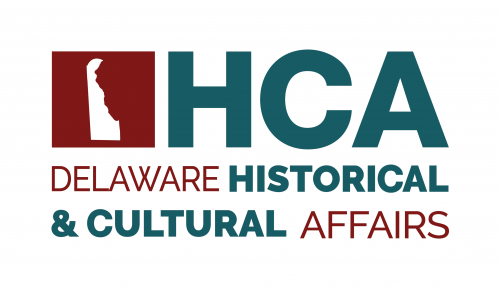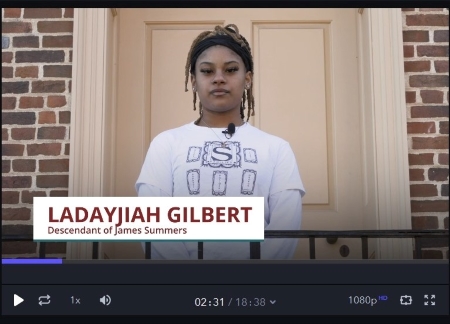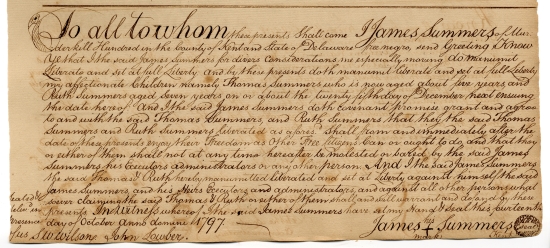Video Explores Four Enslaved People and An Abolitionist
Historical and Cultural Affairs | Newsroom | Date Posted: Monday, December 7, 2020
Historical and Cultural Affairs | Newsroom | Date Posted: Monday, December 7, 2020



Delaware Day honors the anniversary of Delaware becoming the first state to ratify the U.S. Constitution on Dec. 7, 1787. Traditionally, the day’s activities focused on the five Delaware signers of the Constitution — Richard Bassett, Gunning Bedford Jr., Jacob Broom, John Dickinson and George Read. As members of the remarkable group of men who founded the United States, their lives and accomplishments have been celebrated and well documented in the historical record.
In 2020, however, the division sought to expand the Delaware Day narrative by spotlighting the lives of five other people who contributed to Delaware’s early history and whose stories also deserve to be told and preserved — Dinah, James Summers, Bishop Richard Allen, Warner Mifflin and an unnamed Black male who was one of the first people of African origin to live in Delaware.
In creating “Delaware Day 2020 — Expanding the Delaware Story” division Director Tim Slavin noted that “we are striving to practice inclusive history and will not shrink from, or ignore the pain of, our shared heritage. We are committed to both preserving and interpreting Delaware’s difficult history.”
Following is information on each of the individuals portrayed in “Delaware Day 2020 — Expanding the Delaware Story:
James Summers
James Summers was born a free Black man in the later part of the 18th century. He married an enslaved woman, meaning his children were enslaved at birth. By 1797, he had worked out an arrangement with the family that held his children in bondage and was able to sign the manumission document setting them free in the Recorder of Deeds office in the State House (now Old State House) in Dover, Delaware.
Bishop Richard Allen
Richard Allen was born enslaved on Feb. 14, 1760. As a young child, he and his family were sold to Stokely Sturgis of Dover, Delaware. Sturgis permitted Allen to attend religious meetings and, later, to purchase his own freedom. Allen joined the Methodist Church and preached in Delaware and adjoining states. He was a founder and first bishop of the African Methodist Episcopal Church which was established in Philadelphia in 1816. Allen died on March 26, 1831.
Burial #9, Unnamed Black Male, Avery’s Rest
In 2014, archaeologists working at the Avery’s Rest site west of Rehoboth Beach, Delaware excavated 11 human burials. Scientific and DNA analysis determined that three of the individuals were of African origin. Historical context suggests these were Black people enslaved by John Avery. One burial, dated between 1674 and 1714, was that of an unnamed Black male who, at death, was between the ages of 32 and 42. The division is committed to restoring the dignity of these individuals and their rightful place in the history of Delaware.
Keep up to date by receiving a daily digest email, around noon, of current news release posts from state agencies on news.delaware.gov.
Here you can subscribe to future news updates.
Historical and Cultural Affairs | Newsroom | Date Posted: Monday, December 7, 2020



Delaware Day honors the anniversary of Delaware becoming the first state to ratify the U.S. Constitution on Dec. 7, 1787. Traditionally, the day’s activities focused on the five Delaware signers of the Constitution — Richard Bassett, Gunning Bedford Jr., Jacob Broom, John Dickinson and George Read. As members of the remarkable group of men who founded the United States, their lives and accomplishments have been celebrated and well documented in the historical record.
In 2020, however, the division sought to expand the Delaware Day narrative by spotlighting the lives of five other people who contributed to Delaware’s early history and whose stories also deserve to be told and preserved — Dinah, James Summers, Bishop Richard Allen, Warner Mifflin and an unnamed Black male who was one of the first people of African origin to live in Delaware.
In creating “Delaware Day 2020 — Expanding the Delaware Story” division Director Tim Slavin noted that “we are striving to practice inclusive history and will not shrink from, or ignore the pain of, our shared heritage. We are committed to both preserving and interpreting Delaware’s difficult history.”
Following is information on each of the individuals portrayed in “Delaware Day 2020 — Expanding the Delaware Story:
James Summers
James Summers was born a free Black man in the later part of the 18th century. He married an enslaved woman, meaning his children were enslaved at birth. By 1797, he had worked out an arrangement with the family that held his children in bondage and was able to sign the manumission document setting them free in the Recorder of Deeds office in the State House (now Old State House) in Dover, Delaware.
Bishop Richard Allen
Richard Allen was born enslaved on Feb. 14, 1760. As a young child, he and his family were sold to Stokely Sturgis of Dover, Delaware. Sturgis permitted Allen to attend religious meetings and, later, to purchase his own freedom. Allen joined the Methodist Church and preached in Delaware and adjoining states. He was a founder and first bishop of the African Methodist Episcopal Church which was established in Philadelphia in 1816. Allen died on March 26, 1831.
Burial #9, Unnamed Black Male, Avery’s Rest
In 2014, archaeologists working at the Avery’s Rest site west of Rehoboth Beach, Delaware excavated 11 human burials. Scientific and DNA analysis determined that three of the individuals were of African origin. Historical context suggests these were Black people enslaved by John Avery. One burial, dated between 1674 and 1714, was that of an unnamed Black male who, at death, was between the ages of 32 and 42. The division is committed to restoring the dignity of these individuals and their rightful place in the history of Delaware.
Keep up to date by receiving a daily digest email, around noon, of current news release posts from state agencies on news.delaware.gov.
Here you can subscribe to future news updates.